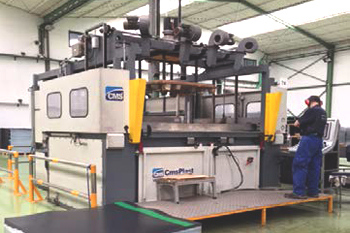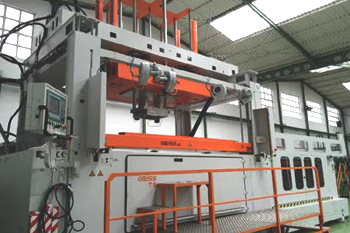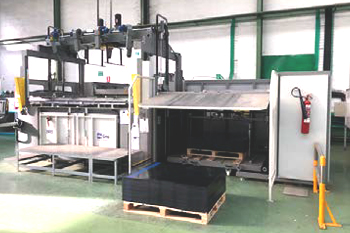
ONE SHEET THERMOFORMING
Maximum size: 3,5 x 2,5 m.
Thickness: from 0.5 mm. up to 12 mm.
Material: HDPE / PET / PP / ABS / TPU+ABS+TPU / ABS+PC / PMMA / ABS+PMMA.
At Rotolia, we can work with three different thermoforming machines: one-sheet, twin-sheet, and blister thermoforming. Our range of machinery means we can work with pieces from 670 mm to 3500 mm and thicknesses that vary between 0.3 and 12 mm, depending on the needs of each product. We work with a wide variety of materials such as HDPE, PET, PP, ABS, TPU+ABS+TPU, ABS+PC, PMMA, ABS+PMMA, PS, and PVC.
Three thermoforming machines for different part sizes.

Maximum size: 3,5 x 2,5 m.
Thickness: from 0.5 mm. up to 12 mm.
Material: HDPE / PET / PP / ABS / TPU+ABS+TPU / ABS+PC / PMMA / ABS+PMMA.

Maximum size: 2,6 x 2 m.
Thickness: from 0.5 mm. up to 8 mm.
Material: PET / PS / ABS / PVC.

Maximum size: 670 x 700 mm.
Thickness: from 0.3 mm. up to 2 mm.
Material: PET / PS / ABS / PVC.
The thermoforming process consists of heating a sheet or plate of semi-finished strong thermoplastic, so it can be adapted to the shape of a mould by vacuum pressure or a counter-mould when it softens. In other words, thermoformable means that it can be adapted to the shape of a mould.
A thermoforming machine can manufacture end products that do not require any further processing, i.e. giving a product its final detail, ensuring it is ready to use. Industrial thermoforming machines are designed to manufacture products through a process commonly called thermoforming. At Rotolia, these products are delivered to the customer in their packaging and ready to use. Thermoformed containers, on the other hand, are containers that are heat moulded. Such containers are often used for ready-made foods, among others.
Thermoforming is used to manufacture products, especially solid surface, thermoplastic, or semi-finished composite materials at high temperatures, helping us produce parts with specific forms. Semi-finished products are usually films and sheets obtained from granular or powdered materials. Thermoforming machines are based on temperature, achieving outstanding flat transformations and 3D materials.
The types of plastics most commonly used in thermoforming are PAI, PP, PSI, PET, ABS, HDPE and PVC. However, foamed PVC, polycarbonate or acrylic can also be thermoformed. Thermoformed PVC is polyvinyl chloride subjected to a thermoforming process. It is in fact the least oil-dependent plastic.
Thermoformed containers are made of PET, PVC and polystyrene, and are used to protect, transport and display a specific product. Thermoformed packages can also be manufactured in fully opaque, transparent or opaque/transparent materials, and can be printed continuously on both sides. They can be applied in the following industries: food, confectionery and beverages, electronics, household appliances, electrical, steel, metal mechanics, pharmaceuticals, chemicals, automotive, textiles, footwear, toys and cosmetics, among many others. Thermoformed containers use the following materials: polyethylene (PE), polypropylene (PP), polyester (PET), polyamide (PA), polystyrene (PS), polyvinyl chloride (PVC), aluminium (AL), and ethyl-vinyl alcohol (EVOH).
Thermoplastic is a plastic that can melt at high temperatures, allowing it to be formed into various shapes. It melts when heated, and hardens when cooled. This characteristic is of great help in recycling plastics, since they can be reheated and shaped into other objects after heating and moulding.
Use the form for any questions you may have about manufacturing techniques, quotes or delivery times, and our technical office team will get back to you at the earliest opportunity.
Data controller:ROTOLIA PLASTICA S.L. / Tax number (CIF): B98737026 /Address: P.I. Mediterráneo – C/ Fila 6, 46550 Albuixech (Valencia) / Email to exercise rights: [email protected] / Telephone: 961 204 910
Main purpose: To answer queries and provide the information requested. To manage the potential commercial/professional relationship.
Rights: Access, rectification, erasure and portability of data, limitation and opposition to its processing, and to not be subject to decisions based solely on the automated processing of data, where appropriate.
Additional information:Additional detailed information about our Privacy Policy can be found in this section.
Find answers to questions about thermoforming, and all its characteristics.
All thermoplastic materials can be thermoformed. At Rotolia, we can work with most of them.
It allows plastic parts to be produced more economically than blow moulding or injection moulding. Furthermore, raw materials that are not viable in other processes can be used. And, finally, the materials are subjected to less stress than in other processes such as injection moulding.
Rotolia will offer you professional advice. However, thermoforming is a process that is recommended for production runs of more than 50 parts. This technology can achieve very complex shapes.
The range of finishing options for thermoformed parts is very extensive. The customer can choose the colour and brightness. As for texture, there is always the option of finishing with coatings such as paint or printing.
A die must always be produced, except for bending or cutting processes on flat sheets.
A plastic moulding system for all our customers’ needs. Technologies to obtain the perfect product.